fuel filter FIAT FULLBACK 2017 Owner handbook (in English)
[x] Cancel search | Manufacturer: FIAT, Model Year: 2017, Model line: FULLBACK, Model: FIAT FULLBACK 2017Pages: 312, PDF Size: 12.31 MB
Page 14 of 312
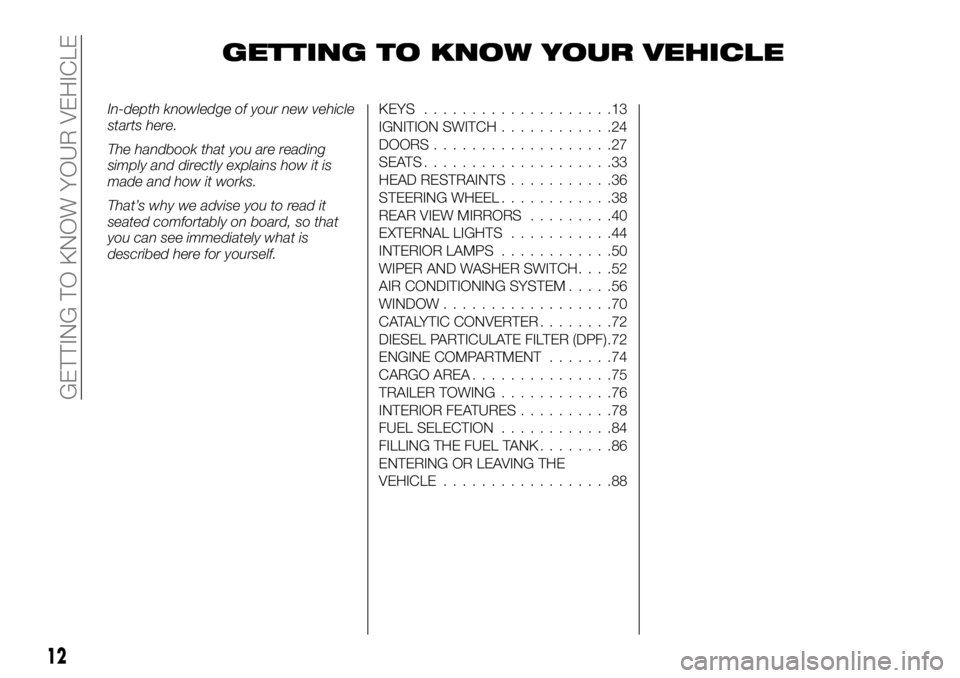
GETTING TO KNOW YOUR VEHICLE
In-depth knowledge of your new vehicle
starts here.
The handbook that you are reading
simply and directly explains how it is
made and how it works.
That’s why we advise you to read it
seated comfortably on board, so that
you can see immediately what is
described here for yourself.KEYS....................13
IGNITION SWITCH............24
DOORS...................27
SEATS....................33
HEAD RESTRAINTS...........36
STEERING WHEEL............38
REAR VIEW MIRRORS.........40
EXTERNAL LIGHTS...........44
INTERIOR LAMPS............50
WIPER AND WASHER SWITCH....52
AIR CONDITIONING SYSTEM.....56
WINDOW..................70
CATALYTIC CONVERTER........72
DIESEL PARTICULATE FILTER (DPF).72
ENGINE COMPARTMENT.......74
CARGO AREA...............75
TRAILER TOWING............76
INTERIOR FEATURES..........78
FUEL SELECTION............84
FILLING THE FUEL TANK........86
ENTERING OR LEAVING THE
VEHICLE..................88
12
GETTING TO KNOW YOUR VEHICLE
Page 74 of 312
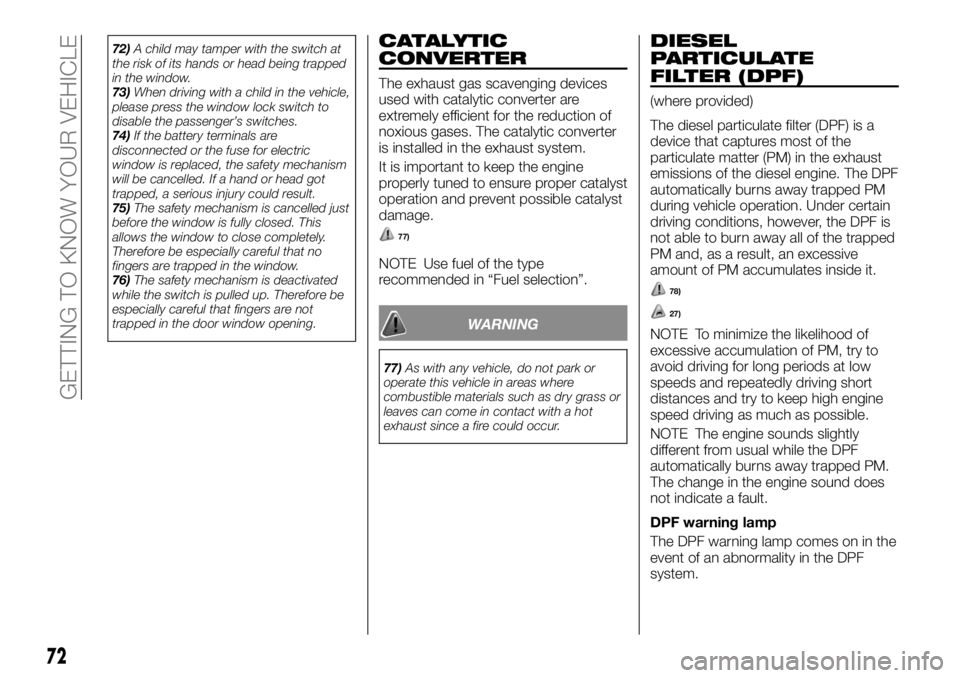
72)A child may tamper with the switch at
the risk of its hands or head being trapped
in the window.
73)When driving with a child in the vehicle,
please press the window lock switch to
disable the passenger’s switches.
74)If the battery terminals are
disconnected or the fuse for electric
window is replaced, the safety mechanism
will be cancelled. If a hand or head got
trapped, a serious injury could result.
75)The safety mechanism is cancelled just
before the window is fully closed. This
allows the window to close completely.
Therefore be especially careful that no
fingers are trapped in the window.
76)The safety mechanism is deactivated
while the switch is pulled up. Therefore be
especially careful that fingers are not
trapped in the door window opening.CATALYTIC
CONVERTER
The exhaust gas scavenging devices
used with catalytic converter are
extremely efficient for the reduction of
noxious gases. The catalytic converter
is installed in the exhaust system.
It is important to keep the engine
properly tuned to ensure proper catalyst
operation and prevent possible catalyst
damage.
77)
NOTE Use fuel of the type
recommended in “Fuel selection”.
WARNING
77)As with any vehicle, do not park or
operate this vehicle in areas where
combustible materials such as dry grass or
leaves can come in contact with a hot
exhaust since a fire could occur.
DIESEL
PARTICULATE
FILTER (DPF)
(where provided)
The diesel particulate filter (DPF) is a
device that captures most of the
particulate matter (PM) in the exhaust
emissions of the diesel engine. The DPF
automatically burns away trapped PM
during vehicle operation. Under certain
driving conditions, however, the DPF is
not able to burn away all of the trapped
PM and, as a result, an excessive
amount of PM accumulates inside it.
78)
27)
NOTE To minimize the likelihood of
excessive accumulation of PM, try to
avoid driving for long periods at low
speeds and repeatedly driving short
distances and try to keep high engine
speed driving as much as possible.
NOTE The engine sounds slightly
different from usual while the DPF
automatically burns away trapped PM.
The change in the engine sound does
not indicate a fault.
DPF warning lamp
The DPF warning lamp comes on in the
event of an abnormality in the DPF
system.
72
GETTING TO KNOW YOUR VEHICLE
Page 75 of 312
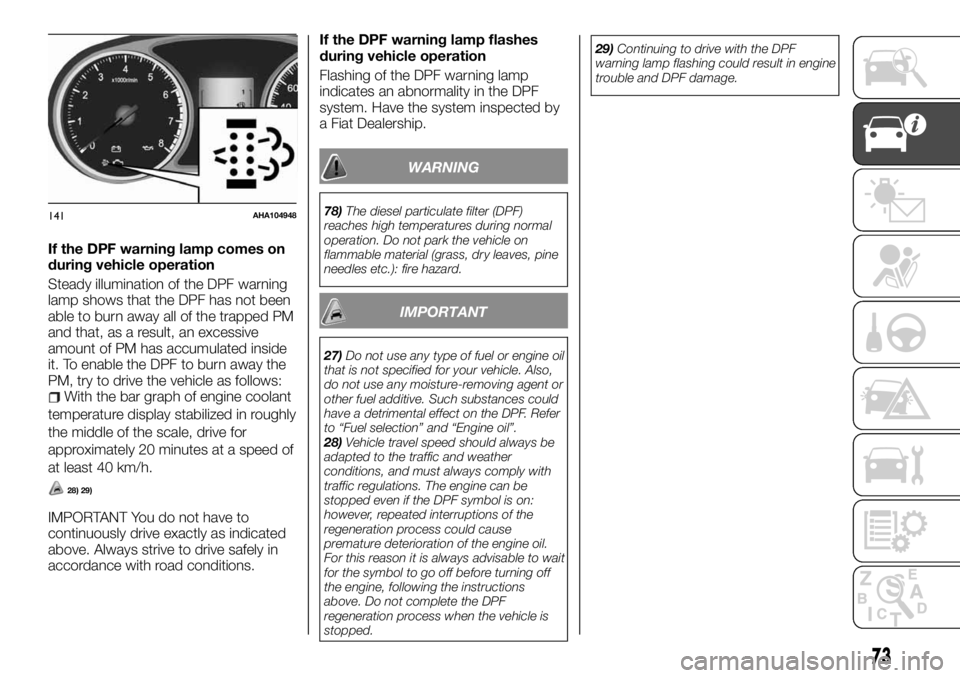
If the DPF warning lamp comes on
during vehicle operation
Steady illumination of the DPF warning
lamp shows that the DPF has not been
able to burn away all of the trapped PM
and that, as a result, an excessive
amount of PM has accumulated inside
it. To enable the DPF to burn away the
PM, try to drive the vehicle as follows:
With the bar graph of engine coolant
temperature display stabilized in roughly
the middle of the scale, drive for
approximately 20 minutes at a speed of
at least 40 km/h.
28) 29)
IMPORTANT You do not have to
continuously drive exactly as indicated
above. Always strive to drive safely in
accordance with road conditions.If the DPF warning lamp flashes
during vehicle operation
Flashing of the DPF warning lamp
indicates an abnormality in the DPF
system. Have the system inspected by
a Fiat Dealership.
WARNING
78)The diesel particulate filter (DPF)
reaches high temperatures during normal
operation. Do not park the vehicle on
flammable material (grass, dry leaves, pine
needles etc.): fire hazard.
IMPORTANT
27)Do not use any type of fuel or engine oil
that is not specified for your vehicle. Also,
do not use any moisture-removing agent or
other fuel additive. Such substances could
have a detrimental effect on the DPF. Refer
to “Fuel selection” and “Engine oil”.
28)Vehicle travel speed should always be
adapted to the traffic and weather
conditions, and must always comply with
traffic regulations. The engine can be
stopped even if the DPF symbol is on:
however, repeated interruptions of the
regeneration process could cause
premature deterioration of the engine oil.
For this reason it is always advisable to wait
for the symbol to go off before turning off
the engine, following the instructions
above. Do not complete the DPF
regeneration process when the vehicle is
stopped.29)Continuing to drive with the DPF
warning lamp flashing could result in engine
trouble and DPF damage.
141AHA104948
73
Page 100 of 312
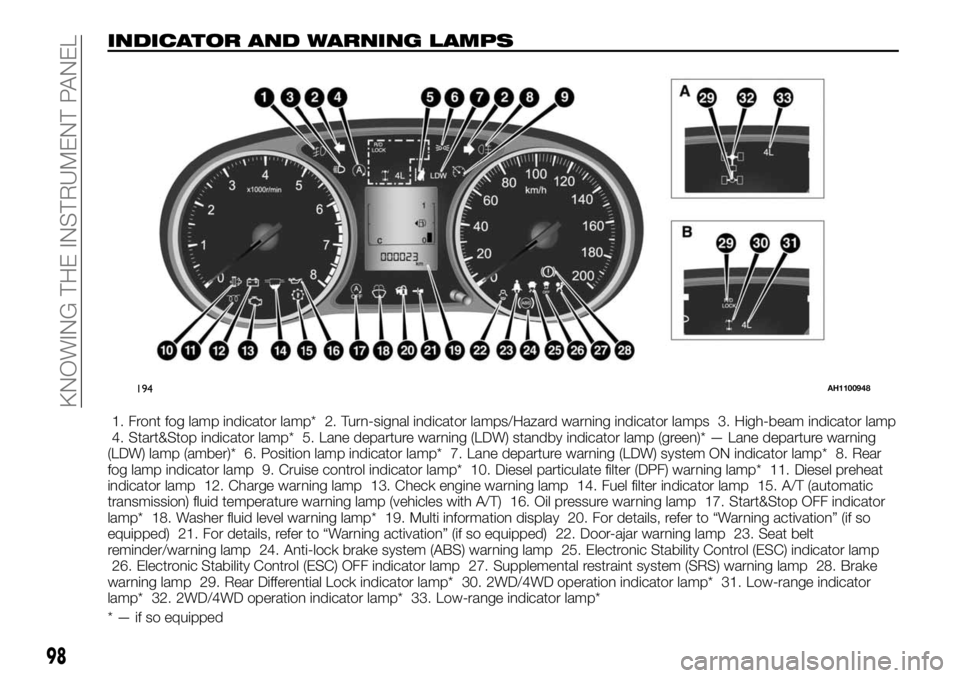
INDICATOR AND WARNING LAMPS
1. Front fog lamp indicator lamp* 2. Turn-signal indicator lamps/Hazard warning indicator lamps 3. High-beam indicator lamp
4. Start&Stop indicator lamp* 5. Lane departure warning (LDW) standby indicator lamp (green)* — Lane departure warning
(LDW) lamp (amber)* 6. Position lamp indicator lamp* 7. Lane departure warning (LDW) system ON indicator lamp* 8. Rear
fog lamp indicator lamp 9. Cruise control indicator lamp* 10. Diesel particulate filter (DPF) warning lamp* 11. Diesel preheat
indicator lamp 12. Charge warning lamp 13. Check engine warning lamp 14. Fuel filter indicator lamp 15. A/T (automatic
transmission) fluid temperature warning lamp (vehicles with A/T) 16. Oil pressure warning lamp 17. Start&Stop OFF indicator
lamp* 18. Washer fluid level warning lamp* 19. Multi information display 20. For details, refer to “Warning activation” (if so
equipped) 21. For details, refer to “Warning activation” (if so equipped) 22. Door-ajar warning lamp 23. Seat belt
reminder/warning lamp 24. Anti-lock brake system (ABS) warning lamp 25. Electronic Stability Control (ESC) indicator lamp
26. Electronic Stability Control (ESC) OFF indicator lamp 27. Supplemental restraint system (SRS) warning lamp 28. Brake
warning lamp 29. Rear Differential Lock indicator lamp* 30. 2WD/4WD operation indicator lamp* 31. Low-range indicator
lamp* 32. 2WD/4WD operation indicator lamp* 33. Low-range indicator lamp*
* — if so equipped
194AH1100948
98
KNOWING THE INSTRUMENT PANEL
Page 102 of 312
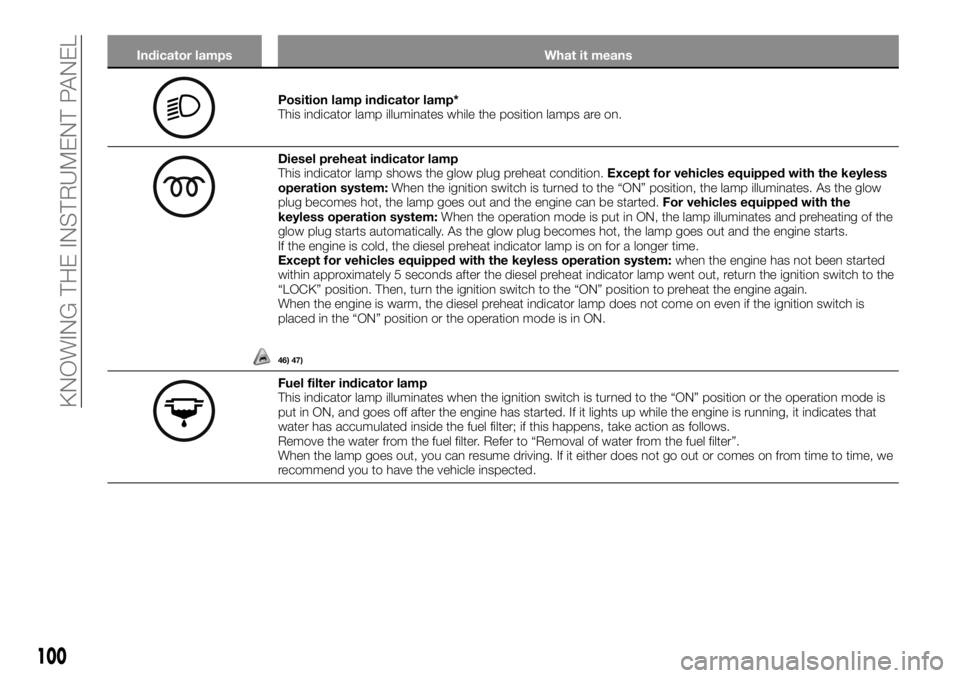
Indicator lamps What it means
Position lamp indicator lamp*
This indicator lamp illuminates while the position lamps are on.
Diesel preheat indicator lamp
This indicator lamp shows the glow plug preheat condition.Except for vehicles equipped with the keyless
operation system:When the ignition switch is turned to the “ON” position, the lamp illuminates. As the glow
plug becomes hot, the lamp goes out and the engine can be started.For vehicles equipped with the
keyless operation system:When the operation mode is put in ON, the lamp illuminates and preheating of the
glow plug starts automatically. As the glow plug becomes hot, the lamp goes out and the engine starts.
If the engine is cold, the diesel preheat indicator lamp is on for a longer time.
Except for vehicles equipped with the keyless operation system:when the engine has not been started
within approximately 5 seconds after the diesel preheat indicator lamp went out, return the ignition switch to the
“LOCK” position. Then, turn the ignition switch to the “ON” position to preheat the engine again.
When the engine is warm, the diesel preheat indicator lamp does not come on even if the ignition switch is
placed in the “ON” position or the operation mode is in ON.
46) 47)
Fuel filter indicator lamp
This indicator lamp illuminates when the ignition switch is turned to the “ON” position or the operation mode is
put in ON, and goes off after the engine has started. If it lights up while the engine is running, it indicates that
water has accumulated inside the fuel filter; if this happens, take action as follows.
Remove the water from the fuel filter. Refer to “Removal of water from the fuel filter”.
When the lamp goes out, you can resume driving. If it either does not go out or comes on from time to time, we
recommend you to have the vehicle inspected.
100
KNOWING THE INSTRUMENT PANEL
Page 213 of 312

162)
6. Examine the radiator hoses for
coolant leakage and the drive belt for
looseness or damage. If there is
anything wrong with the cooling system
or drive belt, we recommend you to
have it checked and repaired.
WARNING
284)Do not open the bonnet while steam
is coming from the engine compartment. It
could cause steam or hot water to spurt
out, causing burns. Hot water could spurt
out even when there is no steam coming
out, and some parts will be very hot. Be
very careful when opening the bonnet.
285)Be careful of hot steam, which could
be blowing off the reserve tank cap.
286)Do not attempt to remove the radiator
cap while the engine is hot.
287)Be careful not to get your hands or
clothes caught in the cooling fan.
288)Make sure that the engine has cooled
down before removing the radiator cap (A),
because hot steam or boiling water
otherwise will gush from the filler port and
may scald you.
IMPORTANT
162)Do not add coolant while the engine is
hot. Suddenly adding cold coolant could
damage the engine. Wait for the engine to
cool down, then add coolant a little at a
time.
BLEEDING THE FUEL
SYSTEM
The fuel system should be bled to
remove air as described below if the
fuel supply is exhausted during travel.
Pump the hand pump (A) at the top of
the fuel filter until the hand pump
becomes stiff.
Then try again to start the engine. If the
engine does not start, repeat the
process above.
289) 290)
WARNING
289)Do not smoke or have any other open
flame near the vehicle while bleeding the
fuel system.
290)Be sure to carefully clean away any
spilt fuel which could ignite and cause a
fire.
TOOLS, JACK AND
JACK HANDLE
Storage
The storage location of the tools, jack
and jack handle should be remembered
in case of an emergency.
Single cab
Type 1
A — Tool (wheel nut wrench)
B — Jack handle
C — Jack
359AHA102090
360AHA104052
211
Page 250 of 312
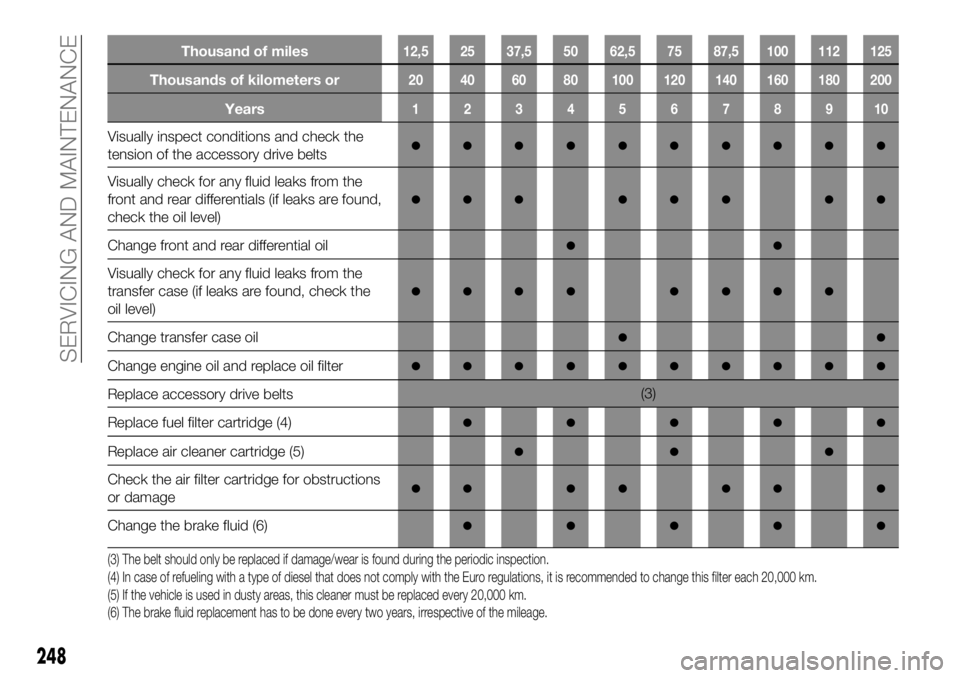
Thousand of miles12,5 25 37,5 50 62,5 75 87,5 100 112 125
Thousands of kilometers or20 40 60 80 100 120 140 160 180 200
Years12345678910
Visually inspect conditions and check the
tension of the accessory drive belts●●●●●●●●●●
Visually check for any fluid leaks from the
front and rear differentials (if leaks are found,
check the oil level)
●●● ●●● ●●
Change front and rear differential oil●●
Visually check for any fluid leaks from the
transfer case (if leaks are found, check the
oil level)
●●●● ●●●●
Change transfer case oil●●
Change engine oil and replace oil filter●●●●●●●●●●
Replace accessory drive belts(3)
Replace fuel filter cartridge (4)
●●●●●
Replace air cleaner cartridge (5)●●●
Check the air filter cartridge for obstructions
or damage●● ●● ●● ●
Change the brake fluid (6)●●●●●
(3) The belt should only be replaced if damage/wear is found during the periodic inspection.
(4) In case of refueling with a type of diesel that does not comply with the Euro regulations, it is recommended to change this filter each 20,000 km.
(5) If the vehicle is used in dusty areas, this cleaner must be replaced every 20,000 km.
(6) The brake fluid replacement has to be done every two years, irrespective of the mileage.
248
SERVICING AND MAINTENANCE
Page 252 of 312
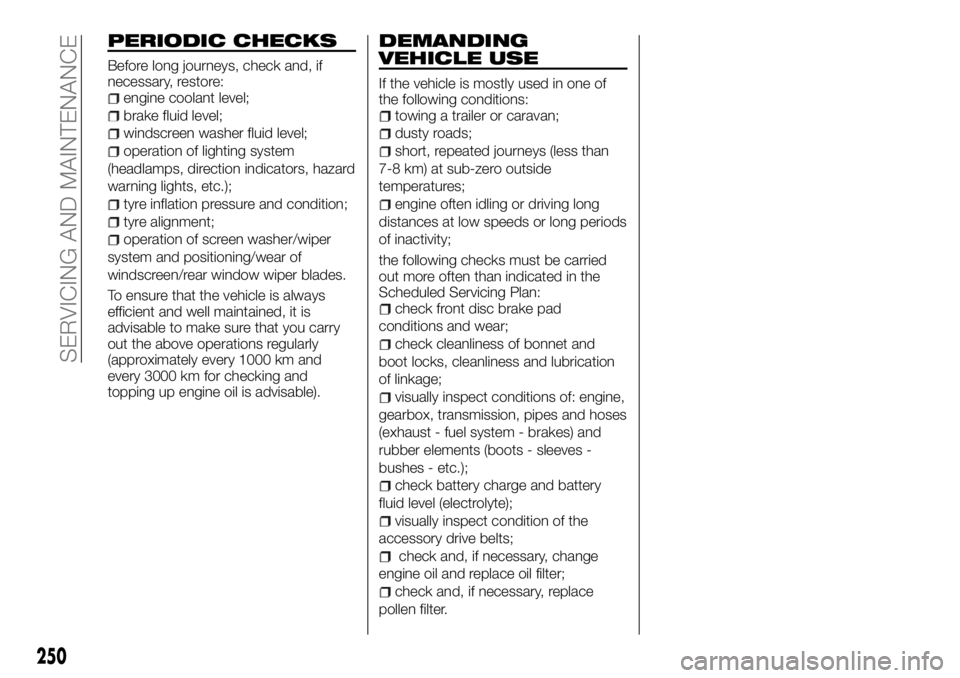
PERIODIC CHECKS
Before long journeys, check and, if
necessary, restore:
engine coolant level;
brake fluid level;
windscreen washer fluid level;
operation of lighting system
(headlamps, direction indicators, hazard
warning lights, etc.);
tyre inflation pressure and condition;
tyre alignment;
operation of screen washer/wiper
system and positioning/wear of
windscreen/rear window wiper blades.
To ensure that the vehicle is always
efficient and well maintained, it is
advisable to make sure that you carry
out the above operations regularly
(approximately every 1000 km and
every 3000 km for checking and
topping up engine oil is advisable).
DEMANDING
VEHICLE USE
If the vehicle is mostly used in one of
the following conditions:
towing a trailer or caravan;
dusty roads;
short, repeated journeys (less than
7-8 km) at sub-zero outside
temperatures;
engine often idling or driving long
distances at low speeds or long periods
of inactivity;
the following checks must be carried
out more often than indicated in the
Scheduled Servicing Plan:
check front disc brake pad
conditions and wear;
check cleanliness of bonnet and
boot locks, cleanliness and lubrication
of linkage;
visually inspect conditions of: engine,
gearbox, transmission, pipes and hoses
(exhaust - fuel system - brakes) and
rubber elements (boots - sleeves -
bushes - etc.);
check battery charge and battery
fluid level (electrolyte);
visually inspect condition of the
accessory drive belts;
check and, if necessary, change
engine oil and replace oil filter;
check and, if necessary, replace
pollen filter.
250
SERVICING AND MAINTENANCE
Page 254 of 312
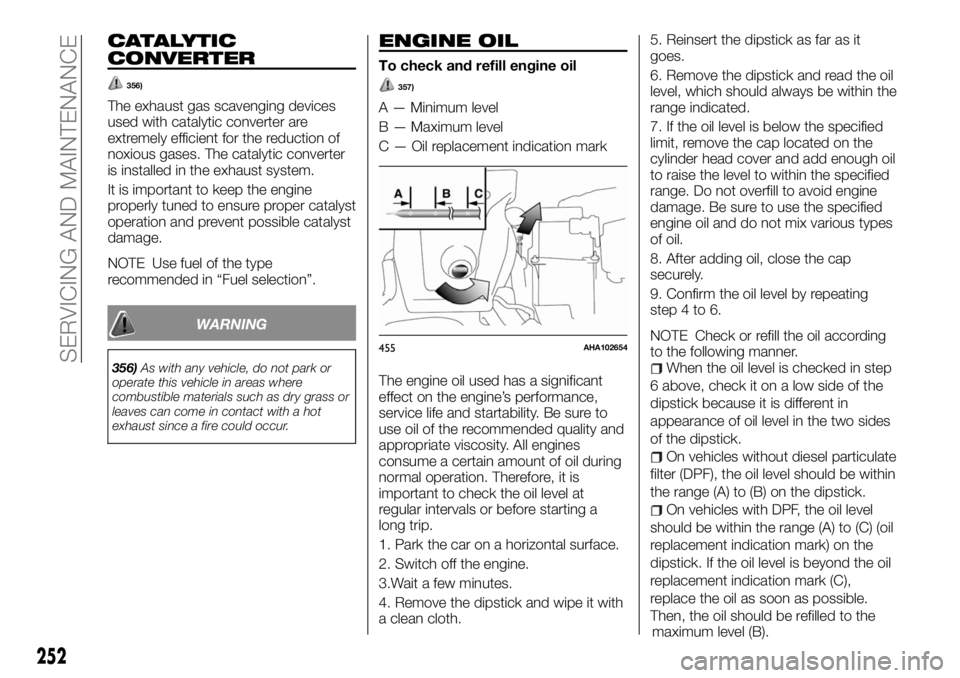
CATALYTIC
CONVERTER
356)
The exhaust gas scavenging devices
used with catalytic converter are
extremely efficient for the reduction of
noxious gases. The catalytic converter
is installed in the exhaust system.
It is important to keep the engine
properly tuned to ensure proper catalyst
operation and prevent possible catalyst
damage.
NOTE Use fuel of the type
recommended in “Fuel selection”.
WARNING
356)As with any vehicle, do not park or
operate this vehicle in areas where
combustible materials such as dry grass or
leaves can come in contact with a hot
exhaust since a fire could occur.
ENGINE OIL
To check and refill engine oil
357)
A — Minimum level
B — Maximum level
C — Oil replacement indication mark
The engine oil used has a significant
effect on the engine’s performance,
service life and startability. Be sure to
use oil of the recommended quality and
appropriate viscosity. All engines
consume a certain amount of oil during
normal operation. Therefore, it is
important to check the oil level at
regular intervals or before starting a
long trip.
1. Park the car on a horizontal surface.
2. Switch off the engine.
3.Wait a few minutes.
4. Remove the dipstick and wipe it with
a clean cloth.5. Reinsert the dipstick as far as it
goes.
6. Remove the dipstick and read the oil
level, which should always be within the
range indicated.
7. If the oil level is below the specified
limit, remove the cap located on the
cylinder head cover and add enough oil
to raise the level to within the specified
range. Do not overfill to avoid engine
damage. Be sure to use the specified
engine oil and do not mix various types
of oil.
8. After adding oil, close the cap
securely.
9. Confirm the oil level by repeating
step4to6.
NOTE Check or refill the oil according
to the following manner.
When the oil level is checked in step
6 above, check it on a low side of the
dipstick because it is different in
appearance of oil level in the two sides
of the dipstick.
On vehicles without diesel particulate
filter (DPF), the oil level should be within
the range (A) to (B) on the dipstick.
On vehicles with DPF, the oil level
should be within the range (A) to (C) (oil
replacement indication mark) on the
dipstick. If the oil level is beyond the oil
replacement indication mark (C),
replace the oil as soon as possible.
Then, the oil should be refilled to the
455AHA102654
252
SERVICING AND MAINTENANCE
maximum level (B).
Page 255 of 312
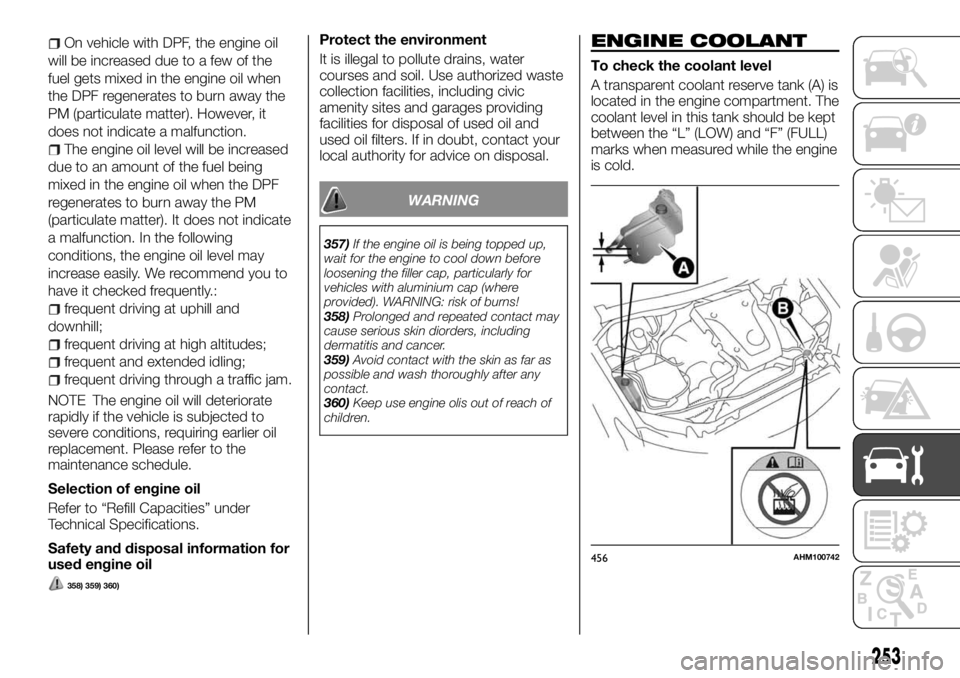
On vehicle with DPF, the engine oil
will be increased due to a few of the
fuel gets mixed in the engine oil when
the DPF regenerates to burn away the
PM (particulate matter). However, it
does not indicate a malfunction.
The engine oil level will be increased
due to an amount of the fuel being
mixed in the engine oil when the DPF
regenerates to burn away the PM
(particulate matter). It does not indicate
a malfunction. In the following
conditions, the engine oil level may
increase easily. We recommend you to
have it checked frequently.:
frequent driving at uphill and
downhill;
frequent driving at high altitudes;
frequent and extended idling;
frequent driving through a traffic jam.
NOTE The engine oil will deteriorate
rapidly if the vehicle is subjected to
severe conditions, requiring earlier oil
replacement. Please refer to the
maintenance schedule.
Selection of engine oil
Refer to “Refill Capacities” under
Technical Specifications.
Safety and disposal information for
used engine oil
358) 359) 360)
Protect the environment
It is illegal to pollute drains, water
courses and soil. Use authorized waste
collection facilities, including civic
amenity sites and garages providing
facilities for disposal of used oil and
used oil filters. If in doubt, contact your
local authority for advice on disposal.
WARNING
357)If the engine oil is being topped up,
wait for the engine to cool down before
loosening the filler cap, particularly for
vehicles with aluminium cap (where
provided). WARNING: risk of burns!
358)Prolonged and repeated contact may
cause serious skin diorders, including
dermatitis and cancer.
359)Avoid contact with the skin as far as
possible and wash thoroughly after any
contact.
360)Keep use engine olis out of reach of
children.
ENGINE COOLANT
To check the coolant level
A transparent coolant reserve tank (A) is
located in the engine compartment. The
coolant level in this tank should be kept
between the “L” (LOW) and “F” (FULL)
marks when measured while the engine
is cold.
456AHM100742
253